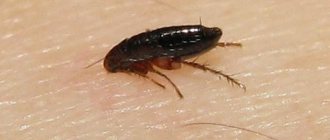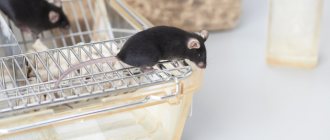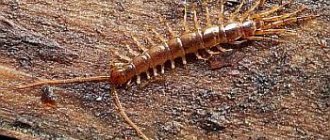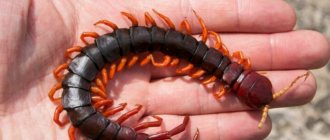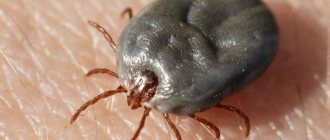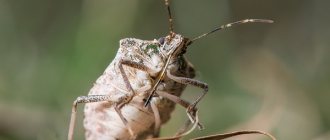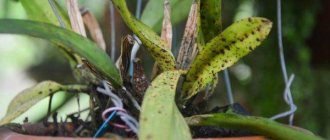Scolopendra - an insect that is classified as a predator. At the same time, scientists agreed that the scolopendra is not an insect at all, but an animal that interacts with the genus of centipedes.
Habitat: different climatic conditions. They are often seen in tropical climates. Various individuals can be found in the desert, forests, mountains, caves and other places. Do not forget that you may also encounter centipedes in your house or apartment. In climates where it is not so hot, the centipede can grow up to 20 centimeters, and in hot climates the length of its body can reach 28 centimeters.
Appearance of scolopendra
The body of centipedes is quite soft, it contains a component such as chitin. Based on this, centipedes have the property of molting. When their shell has already outgrown its size, at that moment they shed it and wait for a new one to grow. Small individuals “change clothes” once every two months, large individuals change “clothes” twice a year.
Appearance of scolopendra
It is not possible to give exact figures about the size of these centipedes, since they vary depending on their age. The usual size can be 6 centimeters. The largest individual reaches 30 centimeters. The body of these pests itself is divided into a head and a body and divided into segments. There are about 20 of them.
Interesting fact: if a scolopendra runs across a person’s body, there will be a slippery and burning mark on the body, which will cause irritation.
The centipede's head is composed of one plate, on which there are eyes, two antennae and poisonous jaws, thanks to which it catches its prey. The remaining segments of the body have two limbs. The last two limbs are needed for reproduction and for hunting larger prey.
These individuals have different colors: brown, green, purple, blue and other colors. The color depends on the age of the scolopendra and on the climatic conditions in which it lives.
Centipede lifestyle: nutrition and reproduction
Like many other centipedes, centipedes lead a truly predatory lifestyle. In the wild they feed on small invertebrates, and in some cases large individuals can eat mice, snakes, lizards, frogs and even bats!
Reproduction of centipedes begins in the second year of life. In males, a cocoon with seminal fluid, a spermatophore, is formed in the last ring of the body. At the moment of mating, the female draws fluid into her genitals, and after a few months lays eggs. One clutch can contain up to 120 larvae, not all of which survive. After a few months, the eggs hatch into larvae.
How long does a scolopendra live?
The lifespan of centipedes is about 7 years, which is quite a lot for a representative of arthropods, so they can be considered long-livers.
What types of centipedes are there and where do they live?
There are many species of centipedes, some of which have not even been studied to this day. Below we will talk about those varieties of centipedes that are most often found in everyday life.
Common flycatcher (scutigera)
Scolopendra cutigera is a centipede from the order Scutigeromorpha. The individual is quite mature and can reach 60 millimeters in length. Color yellow-gray. The legs are striped.
Cutigera
Can be found in Europe, North America and the Middle East. Likes to feed on smaller insects.
The place where such a centipede can live is dry foliage. When cold weather comes, he actively begins to look for shelter. It can easily be found in your home. Pay special attention to places where there is high humidity (bathroom, toilet, etc.).
It does not cause harm to both humans and pets. The greatest damage it can cause to a person is redness on the body. It cannot bite through human skin. Its bite is comparable to that of a wasp.
Your property and products are also not threatened by the centipede. In some places, the scolopendra is considered a useful inhabitant, as it eats small insects. If you encounter a scutigera in your apartment, simply catch it and take it outside.
Giant centipede - the largest centipede
Giant scolopendra
You can meet such a centipede in the west and north of South America. Preference in food is also given to insects (like other species), but there have been cases when giant centipedes attacked lizards, huge beetles, mice and rats.
The length of the body can reach 23 segments. The color is brown and red. The legs are covered in yellow.
Scolopendra venom when biting human skin can cause: swelling, severe pain and inflammation, itching, fever, and general intoxication of the body.
The venom of the giant centipede contains: acetylcholine, serotonin, lecithin, histamine, thermolysin and hyaluronidase.
Important! Symptoms may appear after several days. If you notice any of these, contact your doctor immediately and take a consultation.
If you encounter this type of pest in your apartment, get rid of it as soon as possible.
Ringed scolopendra (Crimean)
Ringed scolopendra (Crimean)
This type of centipede can be found in Italy, Spain, France and the countries of the Mediterranean basin.
The size of the Crimean centipede can be up to 15 centimeters, no more.
It feeds on almost all insects, beetles, lizards, and others that are smaller in size.
The poison is not toxic, unlike its older relative.
Chinese red scolopendra
Its habitat is Australia and East Asia. Compared to other species, it has less aggression and is more social. Can exist with its relatives. Although, scolopendras are loners by nature.
This species is popular in Chinese medicine. They accelerate skin diseases and various injuries.
Chinese red scolopendra
California scolopendra
Habitats: Mexico and arid areas in the USA. She loves drought, unlike her relatives.
The bite of the California centipede can cause a slight itching and burning sensation on the human body. There are cases when rhabdomyolysis and acute renal failure developed after a bite.
California scolopendra
Scolopendra Lucas
Can be found in southern Europe. The appearance differs from its relatives in that the Lucas scolopendra has a heart-shaped head and a rusty color. There will be virtually no harm after a bite from such a centipede. Only slight itching and inflammation.
Where does scolopendra live?
Considering the huge diversity of species, we can conclude that scolopendra lives almost everywhere. Predatory species are more often found in South America, Australia, North America, but can also be found in Russia, Kazakhstan, Ukraine and Moldova. In search of shelter, they often crawl into residential buildings, especially in the cold season. However, they prefer basements, bathrooms and other rooms with high humidity.
On the street, centipedes often hide in fallen leaves, under tree roots; some species live under stones and even in the ground. Centipedes are especially numerous along the banks of water bodies. Habitats are explained by the preferences of centipedes. They love high temperature and moisture. Therefore, at low temperatures they look for shelter. In addition, hunting in the wild is made more difficult by the fact that insects also disappear from sight, but in residential areas you can still find cockroaches, flies, moths, and so on.
Important: it is worth paying attention to the fact that the vision of centipedes is extremely poorly developed. They can only distinguish between bright light and complete darkness.
Scolopendra bite: what danger does it pose to humans?
The color that remains after the bite indicates that it is dangerous to humans. Different species pose different dangers. Basically, a centipede bite can be compared to the bite of 20 bees or wasps in terms of pain. There will be no death if the person does not have any allergic diseases, otherwise, it is necessary to immediately consult a doctor.
Scolopendra bite
According to scientific sources, the largest size of scolopendra is registered in Brazil. The length of its body is 33 centimeters and its bite is fatal. But this is not a confirmed fact, but only rumors.
In Russia, of course, you cannot meet such large individuals. Here you can see a centipede with a maximum length of 14 centimeters. You can meet it anywhere, on vacation in a tent, in the bathroom and other places. Here it is important to understand how to protect yourself from centipedes:
- If you are camping outdoors, be sure to close your tents well. Before you go to bed, check everything thoroughly for insects.
- Pay attention to clothes and shoes.
- Relax in nature during the day when it is light.
- Be careful when lifting branches and stones.
Why is scolopendra dangerous for humans?
Considering that the front legs and legs contain poison, it is safe to say that centipedes are poisonous. Moreover, the brighter the color, the stronger the poison their body releases. Some millipedes bite in proportion to a wasp or bee. But there are species whose bite can be compared to 20 bee stings at once.
Despite the fact that centipede venom does not lead to death, a fatal outcome cannot be ruled out. The fact is that a person or pet can have an allergic reaction to the poison. Such cases are indeed recorded in history.
Interesting: books describe scolopendra up to 33 centimeters long. Its bite is believed to be fatal. But there is no documentary evidence of this.
Large individuals are mainly found in Brazil and Australia, but in Russia you can find centipedes up to 14 centimeters long. These are mainly ringed scolopendras. They go hunting in the dark and do not attack humans. Of course, if, while collecting firewood in the forest, you grab a log in the place where the centipede is sitting, it can sting in self-defense. But this bite will not be fatal.
Thus, the greatest danger is posed by the giant scolopendra living in South America. But you should stay away even from local centipedes, since there is no guarantee that the body will not overreact to the poison.
A scolopendra bite manifests itself as follows:
- Increased body temperature over 38 degrees.
- Severe pain at the site of the bite.
- Redness of the skin and severe swelling of the tissues.
- Signs of general intoxication.
This condition can persist for 2-3 days, gradually the condition will improve even without treatment.
It is noteworthy that females secrete more concentrated poison, so their bite is more dangerous than the bite of a male.
I was bitten by a scolopendra, what actions to take?
- Wash the area where the bite was recorded thoroughly with clean water and soap, then treat with alcohol.
- Apply a bandage to the bite for several hours, then change it to a new, fresh one.
- Drink plenty of water and rest, this will help the poison leave your body faster.
- Don't drink alcohol.
- Call a doctor immediately.
Small children, pregnant women, people who suffer from cardiovascular diseases should immediately consult a doctor, otherwise there may be dire consequences.
It is important to remember that centipedes do not attack humans first; they try to run away and hide. But if you find it under clothing or in a confined space, it may bite you as a defense.
Scolopendra lifestyle
You can distinguish any type of scolopendra by its characteristic appearance. As already mentioned, centipedes are found both in the wild and in residential areas. In addition, some hobbyists keep these predators at home as pets.
The diet of centipedes includes flies, crickets, worms, cockroaches, moths; large individuals can prey on lizards, small birds, frogs and toads. Millipedes that live in North and South America will not refuse to feast on bats.
During a hunt, the centipede freezes on the surface, waiting for its prey. Due to its compound eyes, it has a wide field of vision, which allows it to closely monitor insects and vertebrates. The centipede also moves very quickly, which allows it to overtake the prey. After this, it pierces its body with its front legs, covers the prey with its entire body and releases poison.
The venom of centipedes is located in the front jaws. Each species has its own concentration of the substance, so the bite of some is not terrible, while others cause a violent reaction in the body. After the centipede has bitten the victim, it begins to slowly eat it. Tearing off pieces from the victim's body with her feet, she sends them down the wide throat. The entire absorption process takes a long time.
The composition of scolopendra venom includes acetylcholine, histamine, lecithin, and serotonin. After the poison enters the tissue, swelling forms. The poison causes paralysis of the victim's body. Due to this, the centipede can calmly start absorbing food.
It is noteworthy that not all centipedes are poisonous. This can be determined by the color of the centipede. The brighter the color, the more poisonous the individual will be. But despite this, centipede venom is not particularly dangerous to humans. In terms of harmfulness, it can be compared to a bee sting. In addition, centipedes do not attack people or pets. A scolopendra can bite as a last resort for the purpose of self-defense.
Scolopendras begin to reproduce only after reaching two years of age. The male develops a sac filled with seed, or a spermatophore, at the end of his body. It is enough for the female to crawl over the male and draw the liquid into her genitals, resulting in fertilization. After a few months, the female will begin to lay eggs.
One clutch often contains up to 120 eggs. The female, up to a certain point, protects the clutch from enemies and surrounds it with her paws. After the small centipedes hatch from the eggs, the mother leaves the shelter. The larvae then grow and molt several times, gradually acquiring the appearance of an adult.
Important: in Crimea there are scolopendras that do not need a male to reproduce, that is, they reproduce parthenogenetically.
The average lifespan of any species of scolopendra is 7 years.
Folk remedies
Such methods will give less effect, but will not affect the health of you and your four-legged friends.
Boric acid
The simplest and most effective method is to apply boric acid to those areas of your floors and baseboards where “uninvited guests” have been noticed. There is no need to mix boric acid with anything.
Adhesive tapes
Here you can be smart and if you don’t have adhesive tape, use double-sided tape. Glue it in the places where you think scolopendras live and glue several flies onto the tape. Centipedes will come for prey and fall into your trap. It is worth noting that this method is only suitable for small centipedes; large individuals can easily get out of the trap and run away.
Giant scolopendra in the desert, video
And in conclusion, an interesting film about scolopendra.
The well-known expression “cockroaches in the head,” which indicates certain characteristics of a person, sometimes becomes a harsh reality. True, sometimes other insects can become an alternative to cockroaches, for example, a centipede that settled in the ear of a Chinese resident, reports the information and analytical portal
Most people who accidentally come into contact with insects or arthropods quickly forget about the unpleasant sensations. But a resident of China will remember his meeting with a centipede for the rest of his life, reports the Federal Post news publication.
According to the Rocket News 24 website, a man named Che woke up at night with severe ear pain and the feeling that something was moving in his auditory organ. The frightened Chinese man woke up his neighbor and told him about the strange symptoms.
https://www.youtube.com/watch?v=ytadvertiseru
At the medical facility, the Chinese described his complaints to the doctors and asked them to figure out what was happening to him as soon as possible. Aesculapians who examined Che's affected ear came to the conclusion that there was a foreign body in his auditory organ.
Doctors asked the patient if he had a habit of placing small objects in his ears. Having received a negative answer, the doctors decided to make sure that the diagnosis was correct: one of them armed himself with tweezers and carefully inserted the instrument into the external auditory canal.
During this manipulation, a hospital employee came across a foreign body, fixed it, and pulled it out. Imagine the amazement of all those present when a wriggling centipede appeared from the Chinese man’s ear.
It turned out that the arthropod that lived in Che’s damp room chose his auditory organ as a burrow and “settled” in a new place of residence in the middle of the night.
Unfortunately, this story did not end with the removal of the centipede. After some time, the Chinese again sought medical help: he complained that his ear and neck were constantly going numb.
After an additional examination, doctors stated that the reason for the man’s deteriorating health was arthropod venom remaining in the external auditory canal. Otolaryngologists also suggested that while the centipede was in the ear, it could have injured the eardrum.
After treatment of the auditory organ, Che was taken home by ambulance. Now the Chinese will have to improve their health with medicines prescribed by specialists.
We suggest you read: Moth with big eyes
Last year, a similar incident occurred with a woman - a spider was in her ear for five days.
Scolopendra is an armored arthropod that belongs to the genus of labiopods, also called Chilopoda or centipede arthropods. It lives in a variety of climates, but prefers tropical climates. Various individuals can live in the desert, mountains, forests, limestone caves and many other places.
These insects live alone. The insect's legs end in poisonous spines. This is precisely why scolopendra, running across a person’s body, can cause irritation. The head includes a head plate with ocelli, a pair of antennae and venomous jaws. They are located under the head, but at the same time they are part of the body.
The color of scolopendra can be different, depending on the species, they are gray, brown, with a yellowish tint. Partially the insect may have a greenish, orange and blue tint. With age, an individual can change colors; pigmentation depends on its habitat.
Scolopendra is soft-bodied and dense in the back. The plate body is connected using a flexible membrane. The exoskeleton consists of chitin. This layer is inanimate and does not grow. To continue to grow, the centipede must undergo a molt.
Is the Chinese red centipede dangerous? If it is dangerous, what are the symptoms and how to treat it or can it kill?
- Well, something like this:
The giant scolopendra can be truly dangerous to humans. This creature can reach 25 cm in length. Not only the bite of a giant scolopendra is poisonous, but also a simple touch to human skin. Its body consists of 21-23 segments; it can be conditionally divided into the head and torso.Each of the scolopendra's 36-40 legs contains poison, so a disturbed creature running across a person's skin leaves serious burns.
A person who has had such contact with any tropical scolopendra is guaranteed severe swelling of the contact site, fever and temperature above 38. The swelling can last a week or two; upon contact with the most poisonous specimens, tissue necrosis may begin. There are also cases where scolopendra venom caused paralysis, muscle spasms, vomiting and interruptions in heart function.
There is a scale for the pain of insect bites, with a bee sting taken as the starting point on the scale. So, contact with scolopendra is about 20 times more painful.
Scientists have already refuted the idea that a scolopendra bite can be fatal. However, if you come into contact with the venom of this creature, you should immediately consult a doctor.
Professional chemicals
Chemistry is an effective way to combat scolopendras, which will help you get rid of them once and for all.
Aerosols from centipedes
Aerosols from centipedes
Spray the areas where the scolopendra runs with an aerosol. On her paws she will carry the poison that you sprayed along with the food into her stomach. If possible, it is better to spray the aerosol directly on the centipede itself.
Liquid insecticides to control millipedes
Often, such products are sold in large containers and need to be diluted. Before use, you must read the instructions. After dilution, apply the product to those places where scolopendra was noticed (corners, baseboards, floors, crevices, etc.).
Why do you dream about scolopendra?
Given the unsightly appearance of centipedes, many believe that seeing one in a dream means trouble. But in practice, dreams with scolopendras are often positive.
Simply seeing a centipede in a dream indicates that you are in pursuit of imaginary values. It may also indicate betrayal. If you often see centipedes in your dreams, take a closer look at the people around you. Perhaps there are envious people among them. When talking with people, try to restrain yourself and not tell anything personal about yourself, much less about your plans. You should not fall into despair, believing that someone has definitely betrayed you. Scolopendra in a dream is a sign that you need to take a closer look at those around you and nothing more.
If the centipede was exaggerated in a dream, had enormous dimensions and looked like a fanatical monster, we can conclude that you are afraid of finding yourself in an extremely difficult situation. And the larger the centipede in a dream, the stronger the fear.
If you dreamed of a group of centipedes, you can assume financial losses. After such a dream, it is better to think several times and not take on new things if you are unsure of their outcome.
Of no small importance is what the centipede did and what the person dreaming did. If scolopendra crawled over the body, then troubles may await you in life, which will result in a nervous breakdown. You should be prepared for this and, if possible, warn.
If a scolopendra bites, this may indicate a deterioration in health in real life. Please note that the more painful the centipede bite was, the more serious diseases can be detected.
If in a dream a scolopendra bites a person sitting next to you and blood appears on the wound, then we can conclude that you are a very sensitive person. You express compassion to the person next to you and may take his problems too close to your heart.
If you killed a centipede in a dream, you can prepare for a trip or trip. According to another dream book, this indicates getting rid of existing problems. The size of the centipede also matters here. The larger it is, the larger problems will be solved.
In addition, killing a centipede may also indicate drastic changes in life. Thus, seeing a centipede in a dream means preparing yourself for changes, be it with your health or with life in general. Such a dream prepares a person in advance and makes it possible to react correctly to changes that arise.
Professional service
If you are unable to overcome scolopendra, use the service of professionals who, when starting treatment, take into account all factors:
- The territory where centipedes live.
- The number of pests in your home.
- Products that were previously used in the fight against centipedes.
The professional service uses two ways to combat scolopendras:
- Cold fog. Professionals irrigate your premises using a special machine. Small particles create a cloud, which settles within a few hours and the millipedes have no chance of getting out from under this cloud.
- Hot fog . This is a dry method of irrigating a room using a special machine that heats chemicals and then sprays them under high pressure. The insecticide particles in this case are even smaller than with cold fog - about 0.5 microns.
Home keeping of scolopendra
As already mentioned, some exotic lovers keep scolopendra at home. Centipedes are not picky when it comes to keeping them and anyone can handle their care. The only thing to keep in mind is that you shouldn’t keep them in pairs. These are still solitary animals, and for two centipedes you will have to equip two terrariums.
The optimal temperature for scolopendra is 25-27 degrees. There should be a high level of humidity. To do this, a drinking bowl is installed in the terrarium, and the substrate is watered. For the latter, coconut substrate with sand in a 1:1 ratio is suitable. It is laid in a layer of 7 centimeters. This way the centipede will be able to dig holes for itself to hide in during the daytime.
For an adult large centipede, a terrarium measuring 30x40x30 centimeters is sufficient. Please note that the size is indicated without the thickness of the soil; accordingly, another 7 centimeters should be added in height. Otherwise, the centipede will be able to crawl out of it.
The most convenient are terrariums that open from the top, so the centipede will not be able to escape. Driftwood, stones, and pieces of bark are suitable as decoration. That is, everything that imitates the natural habitat.
In the wild, the centipede feeds on insects and small vertebrates. At home, you can maintain the same diet. It is enough to feed the centipede once a week. At the same time they give 4-5 crickets. They can be replaced with worms, beetles, cockroaches.
Naturally, you shouldn’t let her go hunting in the house, otherwise you won’t see her again.
Premises prevention
In order not to agonize over the question of how to deal with centipedes, simply follow the recommendations given below, and the chances of centipedes appearing in your apartment will be minimal.
- Ventilate the room regularly.
- Make sure there is plenty of light in the room (scolopendras do not like light).
- Get rid of clutter in attics and basements. In things that have been lying around for years, moisture accumulates, in which centipedes feel comfortable.
- Seal all cracks in the house and apartment with sealant. Place mosquito nets on ventilation shafts.
- Ventilate the basement.
By following all the recommendations and advice given in this article, you will be ensured a normal existence in your apartment or house.
